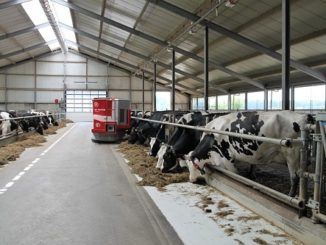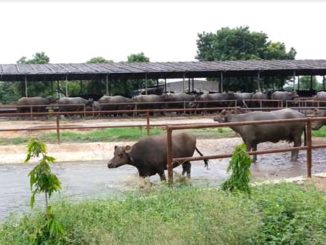Introduction
Endometritis, which implies inflammation of the endometrium, is a common condition of the cow. It does have a profound effect upon the fertility of the animal. The most important cause of endometritis is non-specific, opportunist pathogens (such as Campylobacter fetus and Trichomonas fetus) that contaminate the uterus during the peri-calving period. The causal organisms usually reach the uterus at coitus, insemination, parturition and post-partum. The retention of foetal membrane, abortion, dystocia, mounting by infected bull, unhygienic practices at insemination, hypocalcaemia, season and poor nutrition are the main factors associated with the development of endometritis.
Causes of endometritis
The causal organisms usually reach the uterus from the vagina at coitus, insemination, parturition or postpartum, although it is possible in some circumstances for infection to arrive by the circulation.
Other cause
- Retained fetal membranes
- Dystocia
- Management Factors
- Return of cyclical Ovarian activity
- Bacterial Loading
Retained fetal membranes
- In virtually every survey of the factors causing endometritis, retained fetal membranes are identified as being of major importance.
- Conditions that lead to RFM are also associated with the development of endometritis.
These include:
- Multiple births
- Abortion
- Induced calving
Dystocia
Difficult calving predispose to endometritis for several reasons.
- Firstly, there is a higher than normal incidence of retained fetal membranes in animals that suffered dystocia.
- Secondly, there is often damage to maternal tissues causing devitalisation. The vulval seal may be damaged.
- Thirdly, the obstetrical interventions to correct the dystocia increase the load of pathogens within the uterus.
Management factors
- Many management factors affect the incidence of endometritis. Thus, high milk yield is associated with an increased incidence of endometritis.
- Postpartum metritis was more prevalent in first calvers that yielded less in the last 5 months before calving than those that yielded average or above.
- However, this association is probably dependent upon state of nutrition, rather than milk yield per se.
- Overfeeding is associated with endometritis
- Particularly where animals develop ketosis and fatty liver syndrome.
- Conversely, underfeeding has also been associated with endometritis.
- Season of the year may also affect the incidence of endometritis; cows calving during the winter or spring are more prone to endometritis than those calving at other times.
Return of cyclical ovarian activity
- The uterus of the cow is more resistant to infection at oestrus than during the luteal phase of the cycle.
- Since cellular defence mechanisms are potentiated during oestrus.
- It has been generally assumed that a delay in return to cyclical activity would predispose cows to endometritis.
- The cows that developed pyometra, the average interval from calving to first ovulation was 15.5 days compared with 21.8 days for the normal, non-infected animals.
- Bacterial Loading
- The environment in which the parturient and postparturient cow is kept
- Cows calving in the winter or indoors in the spring are likely to be in a more heavily contaminated environment.
- In the studies of it was found that endometritis is almost invariably a sequel to invasion with A.
- There is good evidence that there is synergism between A. pyogenes and Fusobacterium necrophorum, the latter organism producing a leucocidal endotoxin which interferes with the host’s ability to eliminate A.pyogenes.
- Similarly, Bacteroides also produce substances that interfere with the phagocytosis and killing of bacteria.
Diagnosis of endometritis
- History
- Clinical signs
- Rectal examination
- Vaginoscopy
- Uterine biopsy
- Bacterial culture
- In most cases a diagnosis is based upon the presence of an abnormal vulval discharge, usually with the presence of varying amounts of pus.
- When small quantities of pus are present, particularly in the absence of an unpleasant odour, then it is usually indicative of the spontaneous recovery phase.
Whiteside test
Cervical mucus is collected aseptically and mixed with equal volume of 5 % NaOH in a test tube. The mixture is heated up to the boiling point and the intensity of colour change is graded as
| Color | Degree of Endometritis |
| Turbid | Normal |
| Light yellow | Mild |
| Yellow | Moderate |
| Dark yellow | Severe |
Endometrial biopsy
Relatively easy and safe procedure for the practicing veterinarian to performs. Its use in conjunction with a detailed history, rectal and vaginal examinations and microbial cultures can lead to a more accurate prognosis of difficult breeders and greater therapeutic efficiency. Biopsy lesions heal rapidly and hemorrhages are of little or no clinical significance. Biopsy specimen should be sufficient size (4 x 6 mm). Specimens should be taken from both the uterine horns and body due to variability of pathology in each section. Albuchin’s uterine biopsy catheter is used to obtain in vivo uterine endometrial samples. Proper disinfection and sterilization of the biopsy instrument are necessary to prevent microbial contamination. Before taking biopsy, thoroughly scrub and clean the vulva and perineal area. Evert the vulvas lips and introduce the biopsy instrument in closed position through vagina into uterus. Gently push the piston to open the cutting edge. Press a portion of the uterine wall into the cavity of the cutting edge. Pull the piston caudally to close the cutting edge so as to remove a piece of the endometrial. Withdraw the instrument out of the reproductive tract in closed position. Remove the endometrial tissue from the instrument and immediately transfer it into 10 % neutral buffered formalin solution at room temperature. Tissues are trimmed, dehydrated, cleared and embedded in paraffin sections and cut at a thickness of 5 – 6 micron and stained with haematoxilin and eosin stain for histological examination.
Clinical signs
- Clinical signs of endometritis are the presence of a white or whitish-yellow muco-purulent vaginal discharge (known as leucorrhoea or ‘whites’) in the postpartum cow.
- The volume of the discharge is variable, but frequently increases at the time of oestrus when the cervix dilates and there is copious vaginal mucus.
- The cow rarely shows any signs of systemic illness, although in a few cases milk yield and appetite may be slightly depressed.
- Rectal palpation frequently shows a poorly involuted uterus which has a ‘doughy’ feel.
- Studer and Morrow (1978) found a close correlation between size and texture of uterus and cervix, the nature of the purulent exudate and the degree of endometritis determined by biopsy and the nature of the bacterial isolation.
Treatment of endometritis
- There is little value in performing routine swabbing and bacterial sensitivity tests before treatment.
- A wide range of antiseptics, antimicrobial agents and hormones have been used as treatments for endometritis.
- Many cases of endometritis are self-limiting and resolve after the resumption of oestrous cyclicity.
- The self-cure rate has been estimated at 33% Yet, although endometritis is frequently self-limiting, with spontaneous recovery after a spontaneous oestrus, there is a danger that non-treatment will lead to the development of pyometra.
- In the treatment of chronic endometritis with antimicrobial substances, it is preferable to administer the substance by the intrauterine route.
- Provided an adequate dose rate is used, this will result in effective minimum inhibitory concentrations (MICs) reaching the endometrium and being established in the intraluminal secretions.
- Some clear principles underlie the choice of antimicrobial and/or antiseptic agents
-
- Its efficacy against the wide range of aerobic and anaerobic, Gram-positive and Gram-negative bacteria that will be present.
- Its efficacy within the generally anaerobic environment of the uterus.
- Whether an effective bactericidal (or bacteriostatic) concentration can be achieved at the site of infection by the route of administration. When the intrauterine route is used, the substance must be evenly and rapidly distributed throughout the uterine lumen with good penetration into the deeper layers of the endometrium.
- It must not inhibit natural uterine defense mechanisms, particularly the cellular component.
- It must not traumatize the endometrium. Examples include: propylene glycol, cause necrotizing endometritis; which can cause granulomata. And chalky bases, which leads to irritation and blockage of glands.
- Treatment must be cost-effective
- Details of its absorption from the uterus and excretion in the milk must be known so that appropriate withdrawal times can be followed.
- Nitrofurazone is Irritant and has an adverse effect on fertility.
- Aminoglycosides are not effective in the predominantly anaerobic environment of the infected uterus.
- Sulphonamides are ineffective because of the presence of paraaminobenzoic acid metabolities in the lumen of the infected uterus.
- Penicillins are susceptible to degradation by the large numbers of penicillinase producing bacteria that are present.
- A broad-spectrum antibiotic, such as oxytetracycline, used at a dose rate of up to 22 mg/kg, will provide effective MICs in the lumen and uterine tissues. Considerable concentrations of antibiotic reach the endometrium following intravenous or intramuscular injection.
- When a corpus luteum is present (i.e. during the luteal phase of the oestrous cycle or when there is a pathologically retained corpus luteum) PGF2α causes luteolysis, thereby stimulating the return of oestrus and reducing the high progesterone concentrations.
- Intrauterine PGF2α has been advocated as a means of combining luteolytic and ecbolic actions.
- Administration of PGF2α to cases of endometritis with no corpus luteum has also been reported to increase the cure rate.
- The administration of oestrogens by intramuscular injection at the same time as intrauterine infusion of antibiotics has also been recommended.
- However, high dose rates of oestrogens can influence folliculogenesis, resulting in transient or irreversible changes, including ovarian cysts, and can result in long periods of infertility.
- Sheldon and Noakes (1998) compared the effectiveness of intrauterine infusion of 1500 mg oxytetracycline hydrochloride with intramuscular injection of 500 μg cloprostenol (a PGF2α analogue) or 3 mg oestradiol benzoate, as treatments for endometritis.
| The content of the articles are accurate and true to the best of the author’s knowledge. It is not meant to substitute for diagnosis, prognosis, treatment, prescription, or formal and individualized advice from a veterinary medical professional. Animals exhibiting signs and symptoms of distress should be seen by a veterinarian immediately. |






It is very helpful for students, thanks author